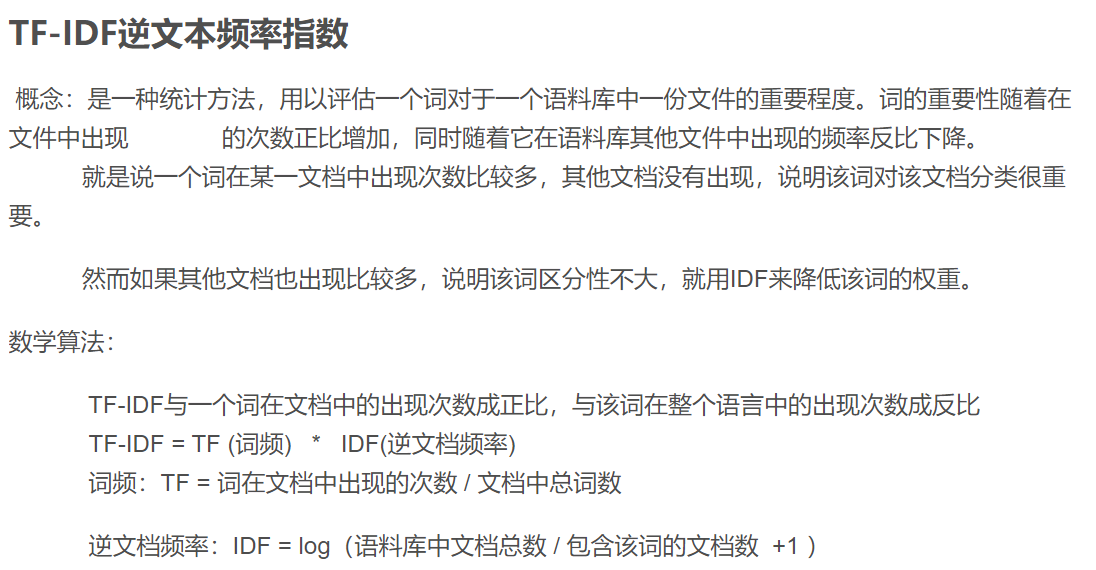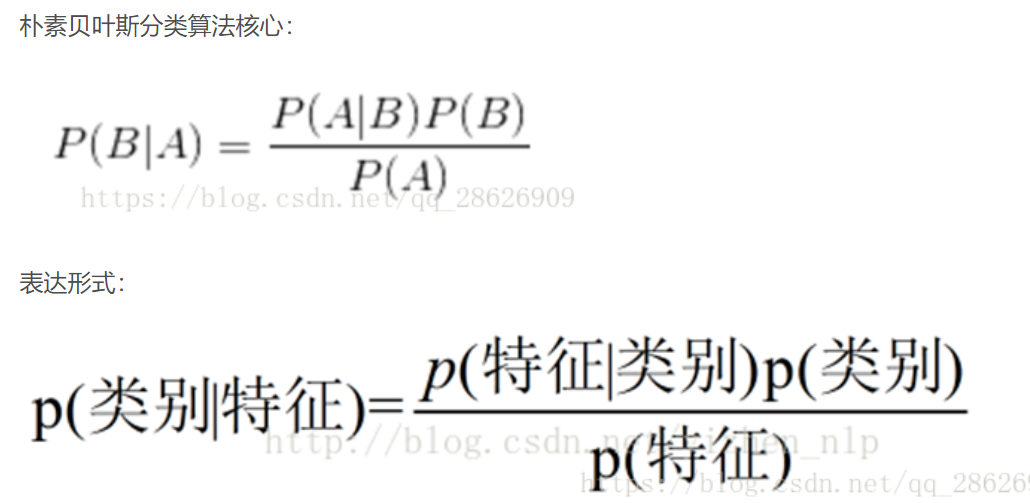一、参考资料
https://blog.csdn.net/qq_28626909/article/details/80382029
二、实验步骤
1.各种读文件,写文件
2.使用jieba分词将中文文本切割
对训练集和数据集中的数据进行切割,分别形成切割后的分词文档
3.对处理之后的文本开始用TF-IDF算法进行单词权值的计算

使用已有的算法和接口,生成训练集和数据集的词频矩阵表和矩阵信息表
4.去掉停用词
避开停用词(啊,吗,的等)
5.贝叶斯预测种类

三、代码实现
1、输入指定文本,预判定文本的种类

# -*- coding: utf-8 -*- from sklearn.multiclass import OneVsRestClassifier # 结合SVM的多分类组合辅助器 import sklearn.svm as svm # SVM辅助器 import jieba from numpy import * import os from sklearn.feature_extraction.text import TfidfTransformer # TF-IDF向量转换类 from sklearn.feature_extraction.text import CountVectorizer # 词频矩阵 def readFile(path): with open(path, 'r', errors='ignore', encoding='gbk') as file: # 文档中编码有些问题,所有用errors过滤错误 content = file.read() file.close() return content def saveFile(path, result): with open(path, 'w', errors='ignore', encoding='gbk') as file: file.write(result) file.close() def segText(inputPath): data_list = [] label_list = [] fatherLists = os.listdir(inputPath) # 主目录 for eachDir in fatherLists: # 遍历主目录中各个文件夹 eachPath = inputPath + "/" + eachDir + "/" # 保存主目录中每个文件夹目录,便于遍历二级文件 childLists = os.listdir(eachPath) # 获取每个文件夹中的各个文件 for eachFile in childLists: # 遍历每个文件夹中的子文件 eachPathFile = eachPath + eachFile # 获得每个文件路径 content = readFile(eachPathFile) # 调用上面函数读取内容 result = (str(content)).replace("\r\n", "").strip() # 删除多余空行与空格 cutResult = jieba.cut(result) # 默认方式分词,分词结果用空格隔开 # print( " ".join(cutResult)) label_list.append(eachDir) data_list.append(" ".join(cutResult)) return data_list, label_list def getStopWord(inputFile): stopWordList = readFile(inputFile).splitlines() return stopWordList def getTFIDFMat(train_data, train_label, stopWordList): # 求得TF-IDF向量 class0 = '' class1 = '' class2 = '' class3 = '' for num in range(len(train_label)): if train_label[num] == '体育': class0 = class0 + train_data[num] elif train_label[num] == '女性': class1 = class1 + train_data[num] elif train_label[num] == '文学出版': class2 = class2 + train_data[num] elif train_label[num] == '校园': class3 = class3 + train_data[num] train = [class0, class1, class2, class3] vectorizer = CountVectorizer(stop_words=stopWordList, min_df=0.5) # 其他类别专用分类,该类会将文本中的词语转换为词频矩阵,矩阵元素a[i][j] 表示j词在i类文本下的词频 transformer = TfidfTransformer() # 该类会统计每个词语的tf-idf权值 cipin = vectorizer.fit_transform(train) tfidf = transformer.fit_transform(cipin) # if-idf中的输入为已经处理过的词频矩阵 model = OneVsRestClassifier(svm.SVC(kernel='linear')) train_cipin = vectorizer.transform(train_data) train_arr = transformer.transform(train_cipin) clf = model.fit(train_arr, train_label) while 1: print('请输入需要预测的文本:') a = input() sentence_in = [' '.join(jieba.cut(a))] b = vectorizer.transform(sentence_in) c = transformer.transform(b) prd = clf.predict(c) print('预测类别:', prd[0]) if __name__ == '__main__': data, label = segText('data') stopWordList = getStopWord('stop/stopword.txt') # 获取停用词表 getTFIDFMat(train_data=data, train_label=label, stopWordList=stopWordList)
2、分批遍历整批文件,筛选出分类错误的文档,并且判断错误率

# -*- coding: utf-8 -*- # @File : TFIDF_naive_bayes_wy.py # @Software: PyCharm import jieba from numpy import * import pickle # 持久化 import os from sklearn.feature_extraction.text import TfidfTransformer # TF-IDF向量转换类 from sklearn.feature_extraction.text import TfidfVectorizer # TF_IDF向量生成类 from sklearn.datasets.base import Bunch from sklearn.naive_bayes import MultinomialNB # 多项式贝叶斯算法 def readFile(path): with open(path, 'r', errors='ignore') as file: # 文档中编码有些问题,所有用errors过滤错误 content = file.read() file.close() return content def saveFile(path, result): with open(path, 'w', errors='ignore') as file: file.write(result) file.close() def segText(inputPath, resultPath): fatherLists = os.listdir(inputPath) # 主目录 for eachDir in fatherLists: # 遍历主目录中各个文件夹 eachPath = inputPath + eachDir + "/" # 保存主目录中每个文件夹目录,便于遍历二级文件 each_resultPath = resultPath + eachDir + "/" # 分词结果文件存入的目录 if not os.path.exists(each_resultPath): os.makedirs(each_resultPath) childLists = os.listdir(eachPath) # 获取每个文件夹中的各个文件 for eachFile in childLists: # 遍历每个文件夹中的子文件 eachPathFile = eachPath + eachFile # 获得每个文件路径 # print(eachFile) content = readFile(eachPathFile) # 调用上面函数读取内容 # content = str(content) result = (str(content)).replace("\r\n", "").strip() # 删除多余空行与空格 # result = content.replace("\r\n","").strip() cutResult = jieba.cut(result) # 默认方式分词,分词结果用空格隔开 saveFile(each_resultPath + eachFile, " ".join(cutResult)) # 调用上面函数保存文件 def bunchSave(inputFile, outputFile): catelist = os.listdir(inputFile) bunch = Bunch(target_name=[], label=[], filenames=[], contents=[]) bunch.target_name.extend(catelist) # 将类别保存到Bunch对象中 for eachDir in catelist: eachPath = inputFile + eachDir + "/" fileList = os.listdir(eachPath) for eachFile in fileList: # 二级目录中的每个子文件 fullName = eachPath + eachFile # 二级目录子文件全路径 bunch.label.append(eachDir) # 当前分类标签 bunch.filenames.append(fullName) # 保存当前文件的路径 bunch.contents.append(readFile(fullName).strip()) # 保存文件词向量 with open(outputFile, 'wb') as file_obj: # 持久化必须用二进制访问模式打开 pickle.dump(bunch, file_obj) # pickle.dump(obj, file, [,protocol])函数的功能:将obj对象序列化存入已经打开的file中。 # obj:想要序列化的obj对象。 # file:文件名称。 # protocol:序列化使用的协议。如果该项省略,则默认为0。如果为负值或HIGHEST_PROTOCOL,则使用最高的协议版本 def readBunch(path): with open(path, 'rb') as file: bunch = pickle.load(file) # pickle.load(file) # 函数的功能:将file中的对象序列化读出。 return bunch def writeBunch(path, bunchFile): with open(path, 'wb') as file: pickle.dump(bunchFile, file) def getStopWord(inputFile): stopWordList = readFile(inputFile).splitlines() return stopWordList def getTFIDFMat(inputPath, stopWordList, outputPath, tftfidfspace_path,tfidfspace_arr_path,tfidfspace_vocabulary_path): # 求得TF-IDF向量 bunch = readBunch(inputPath) tfidfspace = Bunch(target_name=bunch.target_name, label=bunch.label, filenames=bunch.filenames, tdm=[], vocabulary={}) '''读取tfidfspace''' tfidfspace_out = str(tfidfspace) saveFile(tftfidfspace_path, tfidfspace_out) # 初始化向量空间 vectorizer = TfidfVectorizer(stop_words=stopWordList, sublinear_tf=True, max_df=0.5) transformer = TfidfTransformer() # 该类会统计每个词语的TF-IDF权值 # 文本转化为词频矩阵,单独保存字典文件 tfidfspace.tdm = vectorizer.fit_transform(bunch.contents) tfidfspace_arr = str(vectorizer.fit_transform(bunch.contents)) saveFile(tfidfspace_arr_path, tfidfspace_arr) tfidfspace.vocabulary = vectorizer.vocabulary_ # 获取词汇 tfidfspace_vocabulary = str(vectorizer.vocabulary_) saveFile(tfidfspace_vocabulary_path, tfidfspace_vocabulary) '''over''' writeBunch(outputPath, tfidfspace) def getTestSpace(testSetPath, trainSpacePath, stopWordList, testSpacePath, testSpace_path,testSpace_arr_path,trainbunch_vocabulary_path): bunch = readBunch(testSetPath) # 构建测试集TF-IDF向量空间 testSpace = Bunch(target_name=bunch.target_name, label=bunch.label, filenames=bunch.filenames, tdm=[], vocabulary={}) ''' 读取testSpace ''' testSpace_out = str(testSpace) saveFile(testSpace_path, testSpace_out) # 导入训练集的词袋 trainbunch = readBunch(trainSpacePath) # 使用TfidfVectorizer初始化向量空间模型 使用训练集词袋向量 vectorizer = TfidfVectorizer(stop_words=stopWordList, sublinear_tf=True, max_df=0.5, vocabulary=trainbunch.vocabulary) transformer = TfidfTransformer() testSpace.tdm = vectorizer.fit_transform(bunch.contents) testSpace.vocabulary = trainbunch.vocabulary testSpace_arr = str(testSpace.tdm) trainbunch_vocabulary = str(trainbunch.vocabulary) saveFile(testSpace_arr_path, testSpace_arr) saveFile(trainbunch_vocabulary_path, trainbunch_vocabulary) # 持久化 writeBunch(testSpacePath, testSpace) def bayesAlgorithm(trainPath, testPath,tfidfspace_out_arr_path, tfidfspace_out_word_path,testspace_out_arr_path, testspace_out_word_apth): trainSet = readBunch(trainPath) testSet = readBunch(testPath) clf = MultinomialNB(alpha=0.001).fit(trainSet.tdm, trainSet.label) # alpha:0.001 alpha 越小,迭代次数越多,精度越高 # print(shape(trainSet.tdm)) #输出单词矩阵的类型 # print(shape(testSet.tdm)) '''处理bat文件''' tfidfspace_out_arr = str(trainSet.tdm) # 处理 tfidfspace_out_word = str(trainSet) saveFile(tfidfspace_out_arr_path, tfidfspace_out_arr) # 矩阵形式的train_set.txt saveFile(tfidfspace_out_word_path, tfidfspace_out_word) # 文本形式的train_set.txt testspace_out_arr = str(testSet) testspace_out_word = str(testSet.label) saveFile(testspace_out_arr_path, testspace_out_arr) saveFile(testspace_out_word_apth, testspace_out_word) '''处理结束''' predicted = clf.predict(testSet.tdm) total = len(predicted) rate = 0 for flabel, fileName, expct_cate in zip(testSet.label, testSet.filenames, predicted): if flabel != expct_cate: rate += 1 print(fileName, ":实际类别:", flabel, "-->预测类别:", expct_cate) print("erroe rate:", float(rate) * 100 / float(total), "%") # 分词,第一个是分词输入,第二个参数是结果保存的路径 if __name__ == '__main__': datapath = "./data/" #原始数据路径 stopWord_path = "./stop/stopword.txt"#停用词路径 test_path = "./test/" #测试集路径 ''' 以上三个文件路径是已存在的文件路径,下面的文件是运行代码之后生成的文件路径 dat文件是为了读取方便做的,txt文件是为了给大家展示做的,所以想查看分词,词频矩阵 词向量的详细信息请查看txt文件,dat文件是通过正常方式打不开的 ''' test_split_dat_path = "./test_set.dat" #测试集分词bat文件路径 testspace_dat_path ="./testspace.dat" #测试集输出空间矩阵dat文件 train_dat_path = "./train_set.dat" # 读取分词数据之后的词向量并保存为二进制文件 tfidfspace_dat_path = "./tfidfspace.dat" #tf-idf词频空间向量的dat文件 ''' 以上四个dat文件路存储信息 ''' test_split_path = './split/test_split/' #测试集分词路径 split_datapath = "./split/split_data/" # 对原始数据分词之后的数据路径 ''' 以上两个路径是分词之后的文件路径 ''' tfidfspace_path = "./tfidfspace.txt" # 将TF-IDF词向量保存为txt,方便查看 tfidfspace_arr_path = "./tfidfspace_arr.txt" # 将TF-IDF词频矩阵保存为txt,方便查看 tfidfspace_vocabulary_path = "./tfidfspace_vocabulary.txt" # 将分词的词汇统计信息保存为txt,方便查看 testSpace_path = "./testSpace.txt" #测试集分词信息 testSpace_arr_path = "./testSpace_arr.txt" #测试集词频矩阵信息 trainbunch_vocabulary_path = "./trainbunch_vocabulary.txt" #所有分词词频信息 tfidfspace_out_arr_path = "./tfidfspace_out_arr.txt" #tfidf输出矩阵信息 tfidfspace_out_word_path = "./tfidfspace_out_word.txt" #单词形式的txt testspace_out_arr_path = "./testspace_out_arr.txt" #测试集输出矩阵信息 testspace_out_word_apth ="./testspace_out_word.txt" #测试集单词信息 ''' 以上10个文件是dat文件转化为txt文件 ''' #输入训练集 segText(datapath,#读入数据 split_datapath)#输出分词结果 bunchSave(split_datapath,#读入分词结果 train_dat_path) # 输出分词向量 stopWordList = getStopWord(stopWord_path) # 获取停用词表 getTFIDFMat(train_dat_path, #读入分词的词向量 stopWordList, #获取停用词表 tfidfspace_dat_path, #tf-idf词频空间向量的dat文件 tfidfspace_path, #输出词频信息txt文件 tfidfspace_arr_path,#输出词频矩阵txt文件 tfidfspace_vocabulary_path) #输出单词txt文件 ''' 测试集的每个函数的参数信息对照上面的各个信息,是基本相同的 ''' #输入测试集 segText(test_path, test_split_path) # 对测试集读入文件,输出分词结果 bunchSave(test_split_path, test_split_dat_path) # getTestSpace(test_split_dat_path, tfidfspace_dat_path, stopWordList, testspace_dat_path, testSpace_path, testSpace_arr_path, trainbunch_vocabulary_path)# 输入分词文件,停用词,词向量,输出特征空间(txt,dat文件都有) bayesAlgorithm(tfidfspace_dat_path, testspace_dat_path, tfidfspace_out_arr_path, tfidfspace_out_word_path, testspace_out_arr_path, testspace_out_word_apth)
四、遇到的问题
1、遇到使用命令下载包的时候,提示安装成功,但是报错信息仍为未安装某包
原因:安装包的路径并没有在当前使用的环境下,更改指定的下载路径即可




